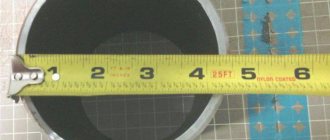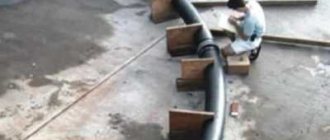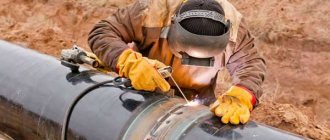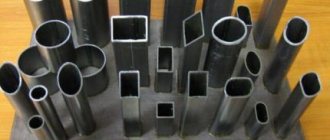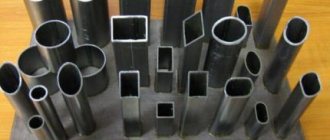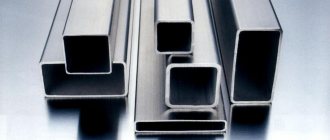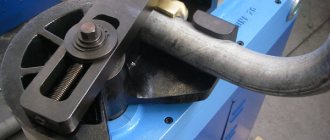During the construction of a house and landscaping of a plot, land owners have to solve many problems. Very often, difficulties are associated with laying various communications where there is an almost insurmountable obstacle: for example, a railway track or a roadway. In this case, a natural question arises about how to lay the pipe under the road. There are several methods for solving the puzzle, but the most popular technology remains “puncture under the road.” You can do it yourself, but first it’s better to get acquainted with this method of trenchless installation of communications, and then learn about alternative options.
Features of trenchless laying
The traditional trench method is not the best solution not only for communications laid under the roadway, because:
- soil removal is impossible without destroying the fertile soil layer;
- the root system of plants is damaged: trees and shrubs in some cases will not be able to avoid death;
- Repairing asphalt roads will cost a significant amount, and this approach is unlikely to please both neighbors and authorities.
- minimal risk of damaging other communications;
- high speed of operation, using almost any method;
- saving money, as well as the ability to carry out work at any time of the year;
- almost absolute harmlessness to the environment (if you don’t ask the opinion of underground inhabitants).
The trenchless method, in which the coating remains intact, is cost-effective. In addition, master craftsmen are attracted by the accessibility of the method for non-professionals. There are other advantages:
The downside is some costs for special drilling equipment and the personnel who service it. However, the advantages in this case are more significant.
What should be done before laying the pipeline?
Development of the project and its approval is the first stage that the owners must complete. Any construction project must have a detailed, accurate plan for laying communications.
Getting approval
Preliminary coordination with local administration authorities will avoid all problems in the future:
An “amateur” connection to the highway without project approval can lead to the same result.
Soil research
If you plan to contact specialists, then such surveys are usually carried out by representatives of a company specializing in pipeline laying. Another option is to invite employees of an organization conducting geodetic work. As a result, the master will know:
All this knowledge will not be superfluous in any case. If we talk only about laying a pipeline, then awareness of the characteristics of the soil will give a 100% chance of avoiding the collapse of a “freshly made” tunnel.
Tips and tricks
For those who are serious about creating a well on their own, the following tips and recommendations will be useful::
- To ensure that the water is always clean and fresh, it is recommended to equip the well in such a way as to ensure air circulation.
- Before using water from a well for daily needs, it is recommended that it be analyzed. As a rule, when the water quality is low, it is necessary to select a suitable filter.
- And finally, you should take water for analysis of composition and domestic needs no earlier than a few days after completion of work, otherwise the results may be unreliable.
Before using a well, it is important to equip it with a filter Source tagbur.ru
How to lay a pipe under the road: methods
A direct puncture is not the only way to pass an obstacle without any losses. When laying highways use:
To determine how to lay a pipe under the road and which option to prefer, you need to pay attention to a number of factors. These include:
Another point under consideration is the economic feasibility of using a particular method. Since the main requirement in this case is to preserve the integrity of the road section, more often the choice is made on a “puncture”. This method is gradually replacing all other pipe laying technologies.
Subtleties of choosing the appropriate method
The method of laying communications using horizontal drilling is chosen at the design stage of a specific process. If trenchless pipe laying is carried out as part of the construction of a facility, for example, a residential building, then the work may become part of the overall construction project.
When designing, the following information is taken into account:
- the length of communications that need to be laid using a trenchless method;
- diameter of the case or pipe;
- the material from which the communications are made;
- the depth to which the pipes must be laid;
- type of pipeline (pressure or non-pressure);
- the ability to install starting and finishing pits of suitable depth;
- access roads to the work site;
- the presence of a sufficiently spacious area for storing materials, equipment, etc.;
- groundwater level;
- other geological features of the site;
- a plan for the location of communications already available on the site.
During the construction process, it is sometimes necessary to change an already drawn up project. This may be due to the desire to reduce costs by using, for example, plastic pipes instead of steel. In addition, the plan for the location of underground communications at the site is not always sufficiently accurate.
The diameter of the pipe is one of the indicators that is taken into account when choosing methods for trenchless installation of communications. The well should be a little larger
When performing work, such unaccounted for pipes or cables may be discovered. All these points may require changes in the project, and this may affect the decision on the drilling method.
If the depth of laying communications is small, there is a danger of subsidence of the top layer of soil, especially if bentonite solution was used during drilling. In such cases, it is better to give preference to horizontal auger drilling.
Very often, the drilling method is determined by what kind of equipment is available to the organization carrying out the order.
For example, if builders have jacks or an installation for horizontal directional drilling, then this will be preferred over the puncture method. Most often, such changes are dictated by considerations of economic benefit.
What is a puncture under the road?
Soil puncture is nothing more than punching (pushing) the soil in the horizontal direction. This option guarantees that the integrity of the road surface will not be compromised. In addition, this process does not require excavation of land. It allows you to lay pipes with a diameter of up to 550 mm, so it is equally suitable for laying water, gas, sewerage, and electrical cables under the road surface.
The desire to avoid unnecessary expenses when laying communications is quite reasonable: construction costs are not small, and horizontal drilling using equipment is relatively inexpensive, but it will still take some money. If you do the work yourself, you can achieve significant benefits - from 30 to 40%. The trenchless installation process itself consists of several stages. This:
Due to the work, the soil under the road becomes denser, but the surface itself remains intact. When the road width is large - over 10 m - a special drilling rig designed for HDD is used. A shorter puncture length makes the work much easier, especially if it is done manually.
Necessary equipment
Mini HDD - device diagram
Equipment for horizontal drilling is quite expensive. But if there is no financial opportunity to purchase such equipment, then you can make a mini HDD with your own hands. This idea is quite feasible, as our craftsmen have repeatedly demonstrated by showing their HDD installations at various forums.
The manufactured equipment is ideal for domestic purposes, as it allows you to perform horizontal drilling with your own hands of any complexity.
For example, when working with pipelines, it is often necessary to make a horizontal move. This process is quite complicated, and only a physically strong person can perform it.
To perform drilling you will need:
- Medium and high power welding machine (inverters can be used, but their frequency power is low).
- A grinder or grinder with 180 or 230 mm discs, and it must be two-handed.
- The consumption of disks will be quite large, so you need to purchase more of them.
- Sledgehammer.
- Reinforcement Ø from 20 mm and a length of 10 cm longer than the hole being drilled and steel pipes of the same length.
- Pump with hose.
- Tub with a volume of 150 l. (recommend larger ones) with a wide neck.
- Drill (can be made by hand).
- Funnel with a hose 2 m long.
How to make a puncture yourself?
As already noted, this manual method is used, but only if the width of the roadway does not exceed 10 m. In this case, the master will need good physical training, but even “Hercules” will not be helped by assistants. Before considering in detail the question of how to lay a pipe under the road, you will have to start looking for equipment, tools and materials.
What will you need to find?
For the operation you need to collect everything you need. The list includes:
You will also need to purchase several pieces of steel pipes of the required diameter.
How to make a puncture with reinforcement?
The process of laying a pipeline manually includes several stages.
- First of all, pits are dug on both sides of the road section where the route will be laid. Their depth and width are greater than those of the main trench. The margin should be 120-130 mm. After this, the axis of the future highway is marked.
- They begin to hammer in a guide - a piece of reinforcement, the end of which is sharpened in advance. As it is buried in the ground, a second one is welded to the first rod, then, if necessary, the next ones. Then they continue to drive the guide into the ground.
- After the reinforcement has come out, a prepared “sleeve” is put on it - a piece of pipe, the working edge of which is sharpened, or teeth are cut on it with a grinder. A hose is inserted into the pipe from behind, it is connected to a pump, which is placed in a barrel of water.
- The rear end of the pipe is hit with a sledgehammer. After it is filled with soil, it is washed out with a stream of water. You can do without a pump, but in this case the work will be more complicated. The sleeve will have to be constantly pulled out and cleared of the ground, and these manipulations can provoke a collapse.
- The pipeline moving into the ground is expanded using welding equipment. The operation is completed when the pointed end of the first element is shown on the opposite side of the road. The reinforcement is pulled out, and the body, which will “work” as a protective case, is left in the ground.
After completing the wiring, the trenches and pits are buried, then the soil is thoroughly compacted.
How to lay “pipes with a pipe”?
In this case, you will also need to purchase materials, and you can make the attachment for the working tool yourself. For the puncture you will need:
This technology is also simple, so the stages of difficulty do not promise. First, a tip is made from tool steel and welded to the pipe.
- As in the previous case, the main work starts with digging. In this case, the entrance trench must be longer than the working pipe with the tip attached. Plus, it is necessary to leave room for “swinging” the sledgehammer.
- Using a level and bricks, the pipe is laid in the center of the trench so that the tip of the tool rests on the soil that will need to be pierced.
- They are armed with a sledgehammer, striking the end until the tip appears on the opposite side.
The final operation is cutting off the tip and deformed end of the pipe with a grinder. If they are going to remove it, then this part of the work is done directly during the laying of the pipeline, otherwise a collapse is possible.
Help from a hand drill
This is another, relatively simple option for those who are not satisfied with the previous methods. In this case, the master will need to purchase a two-meter hand drill: a meter of tool plus a meter of extension. You will also need:
The work looks like this step by step:
- First, trenches are dug on both sides of the road in such a way that it is convenient (while sitting) to turn the drill in them. A guide pole is stuck into the exit side of the future pipeline so that it is not possible to deviate from the desired direction.
- Then they begin the “meeting” in the opposite trench: they turn the drill there (without deviating from the horizontal) until it goes under the road to its entire depth. Then they take a piece of reinforcement, one end of which must be sharpened in advance.
- It is inserted into the drilled hole, the remaining distance is pierced with a sledgehammer, turning the rod from time to time. After the rod breaks through the soil, they take the drill and go to finish what they started in the opposite trench.
If the soil under the road is not too pliable, then it is recommended to make a small excavation from the exit trench in advance, and then securely strengthen it with boards. When the soil at the work site is rocky, obstacles may arise that will have to be heroically overcome.
Drilling rig
Horizontal drilling machines, as one of the automated options
Well construction is carried out not only with the help of a sledgehammer, as they also use a more modern method using a special horizontal drilling installation. This allows large-scale work to be carried out. But the use of such equipment increases the cost of work several times.
The main thing when using such an installation is not to forget that it must be installed in accordance with technologies and standards. Working with drilling equipment requires taking into account all the rules, so before starting work, you need to read the instructions. The drilling rig is divided into two types.
Manual installation
By rotating the pipe, gradual drilling occurs. The soil is washed out in the manner described above; for this, work sometimes has to be interrupted. In this case, it is also advisable to use reinforcement.
Types of manual drilling equipment
Electric
Horizontal drilling is the most common
The drilling machine moves on a rail, so the drilling speed is higher. But in this case, problems often arise when it hits the rock, but if it is not very strong, then the installation will cope with it. The process is faster, but the drilling rig is expensive.
Drilling with modern, high-tech equipment does not always go quickly, so it often hits dense rock. If the process occurs automatically, then a pump with a filter for pumping out must be connected to the reservoir for the washed-out soil.
After finishing drilling with your own hands, in all cases the pipe is left in place, but sometimes it is replaced with polypropylene, because it has a longer service life.
Related video: Horizontal drilling with a homemade drill
Selection of questions
- Mikhail, Lipetsk — What discs should I use for cutting metal?
- Ivan, Moscow - What is the GOST for rolled sheet steel?
- Maxim, Tver - Which racks for storing rolled metal products are better?
- Vladimir, Novosibirsk — What does ultrasonic processing of metals without the use of abrasives mean?
- Valery, Moscow - How to forge a knife from a bearing with your own hands?
- Stanislav, Voronezh — What equipment is used for the production of galvanized steel air ducts?
Horizontal directional drilling method
When the width of the road surface exceeds 10 meters, it is better to use another technology - horizontal directional drilling, or HDD for short. The maximum pipe diameter for this operation is 1200 mm, but private developers do not need such figures. It is possible to lay any highways - both metal and plastic. For horizontal directional drilling, the master will need a special drilling rig designed for this job.
It is installed in the place on the side of the road where the entrance to the pipeline route will be located under the road. To drill a hole, a monitor and locators are used: this equipment will make it possible to avoid even minimal deviations from the given trajectory. HDD is a method that is used to lay communications under any (artificial, natural) objects, at any depth.
Laying a pipeline using a drilling rig also consists of several stages.
- First, they examine the site of future work and study the communications diagram, then prepare trenches and install equipment.
- Then a pilot well is drilled. For punching, a drill head is used, which consists of a pipe and a conical tip made of hard alloy. It has holes designed to supply bentonite drilling fluid. Its tasks are to reduce friction, cool the head, and bring soil to the surface. The body of the working tool is connected to a tubular flexible rod, which is activated by hydraulic jacks.
- After the pilot well has been installed, it is expanded. Before this operation, the drill head is disconnected, and a reverse-action expander - a rimmer - is installed in its place. In order for the hole diameter to be sufficient for the pipeline, the diameter of the expander must be 1.5-2 times larger. The rimmer is rotated and pulled in the direction of the drilling rig.
The last stage is stretching the pipeline. To do this, attach a nozzle with a swivel to the pipe using a hinged earring, which will prevent rotation of the element. The other end of the swivel is connected to the rimmer, after which the pipeline is pulled into the well.
Yes, this is a possible alternative, but it will require additional investment. If anyone is wondering how much it will cost to rent equipment, they say that “hiring” the installation along with the staff will cost on average 1000-1400 rubles per hour. Prices, of course, can rise.
Let's start drilling - important stages of preparation
Do-it-yourself horizontal drilling involves making a puncture using professional equipment. Before you start making a channel under a road or railway tracks, you should prepare for this process. To obtain a drilled hole, it is necessary to level the site on which the equipment will be placed.
The size of the site on which the installation will be placed must be at least 10x15 m. The site is made exactly at the site of the planned puncture under the road. Only after the site of the required size has been prepared can the corresponding equipment and equipment be transported.
After placing the equipment, the anchor installation procedure is carried out, which is implemented using augers. After the anchoring procedure, the process of adjusting the angle of entry of the drill into the ground is carried out.
It is also necessary to first prepare an installation that prepares the bentonite solution. This solution is mixed by a special machine, which should be placed next to the drilling mechanism. The distance between these devices must be at least 10 meters. A bentonite solution is used to strengthen the walls of the well, as well as to remove soil from the channel being drilled.
The preparatory process also includes the following activities:
- Construction of special pits at the entrance and exit of the canal. Excessive amounts of solution will move into these wells.
- Determine the presence of underground communications that should not be affected by the drilling rig.
- Study the nature of the soil, on the basis of which a decision will be made to select the optimal route for drilling.
- Set up communication between the foreman and the equipment operator.
How the process itself will go depends on the preparation stage, so this event should be treated with particular importance. When drilling, safety precautions are observed, on which the health and life of workers depends.
Auger drilling
This is another answer to the question of how to lay a pipe under the road. In this case, the hydraulic unit acts as the main working unit. This trenchless pipeline installation differs from the previous method.
- First, pits are dug. Their depth should be one meter greater than that of the trench. A hydraulic unit with an auger is lowered to the bottom of the inlet area.
- The well is drilled using a compression pipe. Monitor the correct operation of the laser. Part of the soil is removed, creating a hole.
- After the first section with the nozzle almost completely enters the ground, the next element with the auger is attached to it.
- At the moment when the end of the column appears in the opposite pit, it begins to be removed from the well, sequentially removing the augers.
Pipes or cases are immediately installed inside the tunnel. The maximum diameter of such holes is 1720 mm.
Techniques for laying pipeline lines
Among all the known methods of laying pipe lines, the following are most widespread:
- direct puncture;
- so-called “pushing” of the soil;
- drilling (horizontal);
- penetration using shields.
In order to choose the appropriate pipe laying option, you will need to decide on the following things:
- the condition of the soil in the wiring area (including the presence of natural waters in it);
- the nature of the development;
- parameters of isolation of the laid channel from external factors;
- length of laying;
- pipeline diameter;
- economic justification for this particular installation method.
Other pipe routing methods
There are 2 more types of equipment that can be used depending on the characteristics of the soil.
- Hydropuncture. In this case, the equipment is a horizontal drilling installation, on the rod of which a head is put on, piercing the soil with a stream of water. Powerful pressure is created by a centrifugal pump. This technology is optimal for working with sandy or sandy loam soils.
- Vibration puncture Here a pneumatic punch is used, which becomes a “colleague” of a jackhammer: it performs not only rotational, but also reciprocating movements. This method is used for laying pipes in clay soils, as well as in loams.
Both options are worth considering as they are effective and promise minimal time wastage. And serious savings, since even if you rent equipment and invite specialists, the puncture will cost less. They say that the difference can be very noticeable - from 30 to 40%.
Hydro-, vibration puncture and punching
There are hydro- and vibration punctures. In the first case, a water jet is used as a tool for pushing the soil, which shoots out from a special tip under high pressure.
This method is especially effective on cohesive sandy soils that are easily eroded by jets. It allows you to make a hole with a diameter of about 50 cm in a minimum amount of time. But the maximum length of a well with hydraulic puncture is 30 m.
Vibration puncture, as the name implies, is carried out using vibration. The device for performing a puncture uses shock-vibration-pressing installations with exciters of longitudinally directed vibrations.
Static indentation is combined with the impact of a vibratory hammer on the ground. The method is used on water-saturated and low-moisture sandy soils both for laying pipes and for removing them. The diameter of the well can reach 50 cm, and its length – 60 m.
The pushing method is carried out using jacks, just like puncture. But in this case, the pipe is directed into the ground with its open end. As the structure moves forward, a dense plug of soil forms in the pipe, which is then removed.
To perform this type of work, from two to eight powerful (200-400 tons) hydraulic jacks are used, the operation of which requires the installation of a thrust wall with a frame and a cap.
Soil punching is a trenchless method of laying pipes, which is performed using special high-power hydraulic units
During a shift, such a device can penetrate up to 10 meters of soil, and the total length of the well usually does not exceed 80 meters. If it is necessary to lay a longer route, it is divided into separate sections of no more than 80 meters.
This method also requires the construction of an initial and finishing pit, in which the necessary hydraulics are installed.
Drilling of each section is carried out twice: in the forward direction and then in the opposite direction. The operation of the mechanisms and the quality of pressing are monitored by the operator who is in the pit.
Technically, this method is more complicated than a regular puncture, but it can be used on almost any soil. The diameter of the structure can reach 172 cm. The sampling of the core formed inside the pipe can be done manually or by mechanized means.
Does it make sense to do the work yourself?
Before making a final decision on how to lay a pipe under the road, you need to think about the feasibility of this undertaking. If the tunnel is more than 10 meters long, then in this case it is better to avoid the “feat”, since the process will take a lot of time and effort.
The same conclusion can be drawn if there are other underground communications on the site, or if there are difficult-to-pass areas on the territory. Soft soil (sandy, clay) will simplify the task somewhat, but you need to know well not only your site, but also all the features of the stages.
Do-it-yourself piercing can be considered if:
If you have any doubts about your own abilities, and the preparatory work, which may take several weeks, is not inspiring, then it is better to turn to professionals. They will complete the task in a few days. A 100% guarantee of the safety of the road surface and route is another advantage; it still cannot be provided by independent work.
How to lay a pipe under the road? It’s not easy if the master and his assistants chose thankless manual labor and the same tools. It’s easy and fast if most of the work is done by special equipment and professionals. Many craftsmen who decide to make a gasket without the help of equipment encounter unexpected problems. Therefore, it seems that it makes sense to donate a small amount (1000-1500 rubles), but at least avoid unnecessary headaches.
The following video will tell you how to lay pipes under the road with homemade devices:
Was this article helpful? We want to improve. Thanks for your opinion!
Advantages of the puncture method
The demand for the puncture method is explained by its significant advantages compared to other options for performing work of this type. For example, a puncture is available at any time of the year; high or low temperatures of the outside air and soil do not matter much.
One of the advantages of the controlled puncture method is that work can also be carried out in areas with high groundwater levels
The operation of the installation does not require the use of bentonite solution, the supply of water or drilling fluid to the well. This is a compact and powerful unit that is equipped with a reliable electrical safety system. It is not difficult to deliver it to the site and install it. At the same time, its compact dimensions do not prevent the device from working with high power levels.
Trenchless pipe laying methods, such as controlled puncture, can be successfully used in both summer and winter
The work time is also shorter than when using other methods. Even if there is an increased level of groundwater in the area where the puncture is being made, there is no need to take measures to drain water from the area.
During the passage of the expansion cone, the trench walls are also compacted, so additional work in this regard is not required.
If you liked the article, please share it
Previously on the topic:
Share


